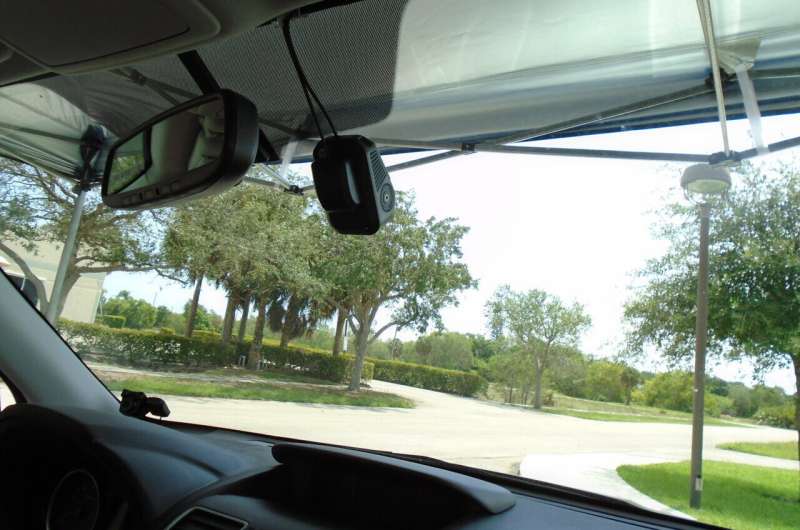This article has been reviewed according to Science X's editorial process and policies. Editors have highlighted the following attributes while ensuring the content's credibility:
fact-checked
trusted source
proofread
Study detects cognitive changes in older drivers using in-vehicle sensors

An estimated 4 to 8 million older adults with mild cognitive impairment are currently driving in the United States, and one-third of them will develop dementia within five years. Individuals with progressive dementia are eventually unable to drive safely, yet many remain unaware of their cognitive decline.
Currently, screening and evaluation services for driving can only test a small number of individuals with cognitive concerns, missing many who need to know if they require treatment.
Nursing, engineering, and neuropsychology researchers at Florida Atlantic University are testing and evaluating a readily and rapidly available, unobtrusive in-vehicle sensing system they have developed. This technology could provide the first step toward future widespread, low-cost early warnings of cognitive change for this large number of older drivers in the U.S. and elsewhere.
In their study, published in the journal BMC Geriatrics, they are systematically examining how this system could detect anomalous driving behavior indicative of cognitive impairment.
Few studies have reported on the use of continuous, unobtrusive sensors and related monitoring devices for detecting subtle variability in the performance of highly complex everyday activities over time. This significant proportion of older drivers constitutes a previously unexplored opportunity to detect cognitive decline.
"The neuropathologies of Alzheimer's disease have been found in the brains of older drivers killed in motor vehicle accidents who did not even know they had the disease and had no apparent signs of it," said Ruth Tappen, Ed.D., principal investigator, senior author and the Christine E. Lynn Eminent Scholar and Professor, FAU Christine E. Lynn College of Nursing.
"The purpose of our study arose from the importance of identifying cognitive dysfunction as early and efficiently as possible. Sensor systems installed in older drivers' vehicles may detect these changes and could generate early warnings of possible changes in cognition."
The study uses a naturalistic longitudinal design to obtain continuous information on driving behavior that is being compared with the results of extensive cognitive testing conducted every three months for three years. A driver-facing camera, forward-facing camera, and telematics unit is installed in the vehicle, and data is downloaded every three months when the cognitive tests are administered.
Researchers are gauging abnormal driving such as getting lost, ignoring traffic signals and signs, near-collision events, distraction and drowsiness, reaction time, and braking patterns. They also are looking at travel patterns such as number of trips, miles driven, miles on the highway, miles during the night and daytime, and driving in severe weather.
The in-vehicle sensor network developed by FAU researchers in the College of Engineering and Computer Science uses open-source hardware and software components to reduce the time, risks, and costs associated with developing in-vehicle sensing units.
In-vehicle sensor systems are kept simple and compact by minimizing complex wiring, limiting the size of the sensing units, and limiting the number of sensors in a vehicle to support the unobtrusiveness of in-vehicle sensors. Each in-vehicle sensor system is comprised of two distributed sensing units: one for telematics data and the other for video data.
Inertial measurement unit data is processed to determine hard braking, hard accelerations, and hard turns, and GPS data. It also includes a timestamp, latitude, longitude, altitude, course over ground, and the number of communicating satellites.
The video unit has built-in artificial intelligence functions that analyze video in real time. The driver-facing camera is mounted in the left corner of the windshield and is directed to the driver's face to analyze his/her behavior and facial expressions. The forward-facing camera is mounted under the rearview mirror and is used to record events external to the vehicle.
Driver-facing indices include face detection, eye detection (open or closed), yawning, distraction, smoking, and mobile phone use. Behavior indices include traffic sign detection (running a red light), object detection (pedestrians, cyclists, curbs, barriers, or nearby vehicles), lane crossing, near-collision, and pedestrian detection.
"These travel-pattern-related driver behavior indices are known to be indicative of the changes in older drivers' cognition and physical functions since they tend to incorporate deliberate avoidance strategies to compensate for age-related deficits," said Tappen. "Driver behavior indices are evaluated for each driver and are summarized on a daily, weekly and monthly basis and are classified into four categories."
A total of 460 study participants will be recruited from Broward and Palm Beach counties in Southeast Florida and are classified into three diagnostic groups: mild cognitive impairment, early dementia, and unimpaired (normal). The Louis and Anne Green Memory and Wellness Center, operated by FAU's College of Nursing, serves as the testing site for a clinical battery including assessments of cognition, functioning in daily activities, and mood (depression), and an additional set of tests including executive function and attention.
"The innovation of our research project lies in the unobtrusive, rapidly and readily available in-vehicle sensing and monitoring system built upon modern open-source hardware and software using existing techniques to develop and customize the components and configure them for this new purpose," said Tappen.
More information: Ruth Tappen et al, Study protocol for "In-vehicle sensors to detect changes in cognition of older drivers", BMC Geriatrics (2023). DOI: 10.1186/s12877-023-04550-5




















